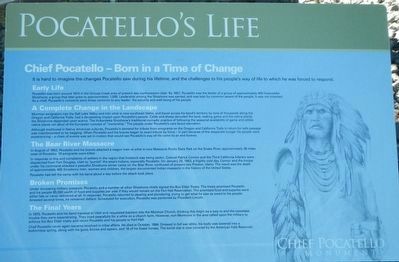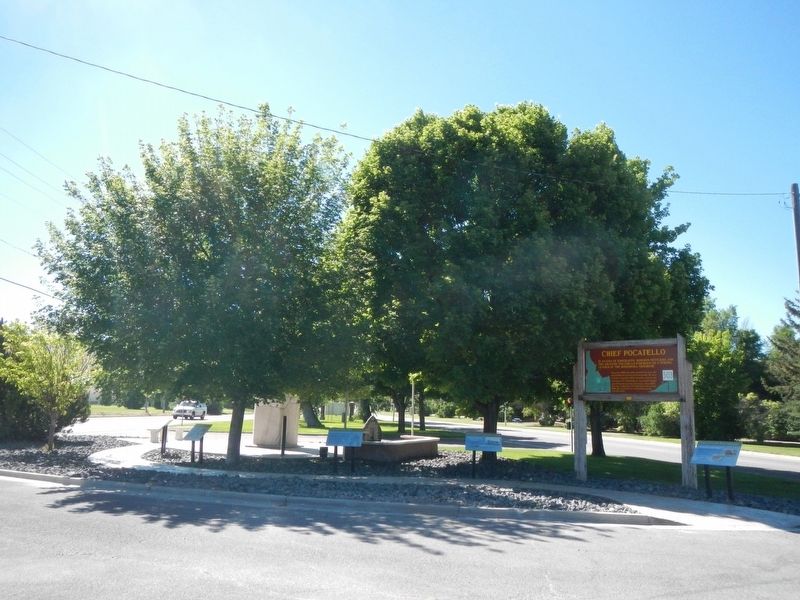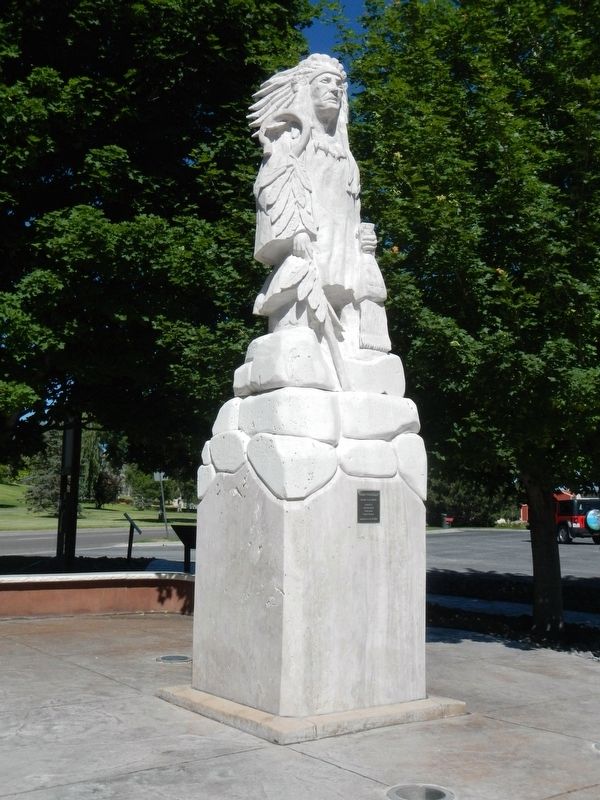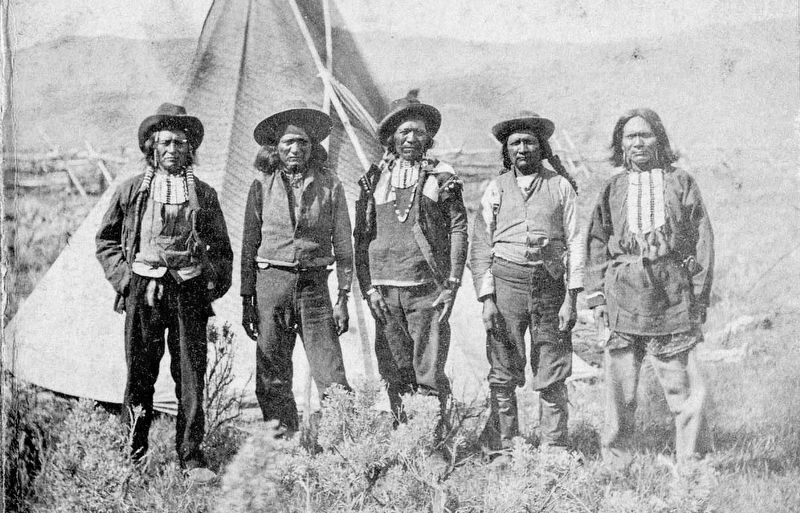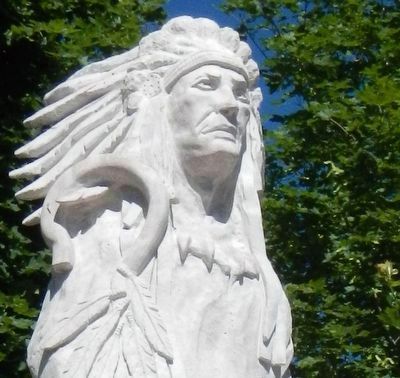Pocatello in Bannock County, Idaho — The American West (Mountains)
Pocatello’s Life
Chief Pocatello Monument
Chief Pocatello - Born in a Time of Change
It is hard to imagine the change Pocatello saw during his lifetime, and the challenges to his people's way of life to which he was forced to respond.
Early Life
Pocatello was born around 1815 in the Grouse Creek area of present-day northwestern Utah. By 1857, Pocatello was the leader of a group of approximately 400 Hukandeka Shoshone, a group that later grew to approximately 1,000. Leadership among the Shoshone was earned, and was kept by common assent of the people. It was not inherited. As a chief Pocatello's concerns were those common to any leader: the security and well being of his people.
A Complete Change in the Landscape
Mormon emigration into the Salt Lake Valley and into what is now southeast Idaho, and travel across his band's territory by tens of thousands along the Oregon and California Trails, had a devastating impact on Pocatello's people. Cattle and sheep denuded the land, making game and the native plants the Shoshone depended upon scarce. The Hukandeka Shoshone's traditional nomadic practice of following the seasonal availability of game and edible native plants ran afoul of the European concept of "ownership." The people under Pocatello's care faced starvation.
Although traditional in Native American cultures, Pocatello's demand for tribute from emigrants on the Oregon and California Trails in return for safe passage was misinterpreted to be begging. When Pocatello and his braves began to exact tribute by force - in part because of the desperate hunger his people were experiencing - a chain of events was set in motion that would see Pocatello's way of life come to an end forever.
The Bear River Massacre
In August of 1862, Pocatello and his braves attacked a wagon trail in what is now Massacre Rocks State Park on the Snake River, approximately 36 miles west of Pocatello. 10 emigrants were killed.
In response to this and companies of settlers in the region that livestock was being stolen, Colonel Patrick Connor and the Third California Infantry were dispatched from Fort Douglas, Utah to "punish" the area's Indians, especially Pocatello. On January 29, 1863, a frigidly cold day, Connor and the troops under his command attacked a peaceful Shoshone winter camp on the Bear River, northwest of present-day Preston, Utah. The result was the death of approximately 400 Shoshone men, women and children, the largest documented Indian massacre in the history of the the United States.
Pocatello had left the camp with his band about a day before the attack took place.
Broken Promises
Under increasing military pressure, Pocatello and a number of other Shoshone chiefs signed the Box Elder Treaty. The treaty promised Pocatello and his people $5,000 worth of food supplies per year if they would remain on the Fort Hall Reservation. The promised food and supplies were either late or never delivered at all. In response, Pocatello returned to stealing and plundering, trying to get what he saw as owned to his people. Arrested several times, he remained defiant. Scheduled for execution, Pocatello was pardoned by President Lincoln.
The Final Years
In 1875, Pocatello and his band traveled to Utah and requested baptism into the Mormon Church, thinking this might be a way to end the ceaseless trouble they were experiencing. They lived peacefully for a while on a church farm. However, non-Mormons in the area called upon the military to enforce the Box Elder treaty and return Pocatello and his people to Fort Hall.
Chief Pocatello, never again became involved in tribal affairs. He died in October, 1884. Dressed in full war attire, his body was lowered into a bottomless spring, along with his guns, knives and spears, and 18 of this finest horses. The burial site is now covered by American Falls Reservoir.
Erected by City of Pocatello.
Topics and series. This historical marker is listed in these topic lists: Native Americans
• Wars, US Indian. In addition, it is included in the Former U.S. Presidents: #16 Abraham Lincoln series list. A significant historical year for this entry is 1884.
Location. 42° 50.782′ N, 112° 25.238′ W. Marker is in Pocatello, Idaho, in Bannock County. Marker is at the intersection of South 5th Avenue and South 4th Avenue, on the left when traveling north on South 5th Avenue. Touch for map. Marker is at or near this postal address: 2695 South 5th Avenue, Pocatello ID 83204, United States of America. Touch for directions.
Other nearby markers. At least 8 other markers are within 2 miles of this marker, measured as the crow flies. The Shoshone (here, next to this marker); Native Foods (here, next to this marker); Pocatello's Name in WWII (here, next to this marker); The City of Pocatello (here, next to this marker); Chief Pocatello (here, next to this marker); Old Fort Hall (approx. 0.2 miles away); Fort Hall (approx. 0.2 miles away); Idaho State University (approx. 1.1 miles away). Touch for a list and map of all markers in Pocatello.
More about this marker. This marker is located at the Visit Pocatello Idaho Tourist Information Center.
Also see . . . Chief Pocatello (1815-1884) - Latin Library. Pocatello and his people began to confront the wagon
trains and the Mormons, demanding food to replace what the white people had used or chased away. The Mormons gave them what they wanted, figuring it was better to concede than go to war. The wagon trains did not feel the same way. They threatened war to the Indians if they continued to harass them. Soon Pocatello was being blamed for every Indian atrocity in that part of the country. (Submitted on September 15, 2017, by Barry Swackhamer of Brentwood, California.)
Credits. This page was last revised on July 25, 2022. It was originally submitted on September 15, 2017, by Barry Swackhamer of Brentwood, California. This page has been viewed 871 times since then and 122 times this year. It was the Marker of the Week July 24, 2022. Photos: 1, 2, 3. submitted on September 15, 2017, by Barry Swackhamer of Brentwood, California. 4. submitted on July 23, 2022, by J. J. Prats of Powell, Ohio. 5. submitted on September 15, 2017, by Barry Swackhamer of Brentwood, California.
